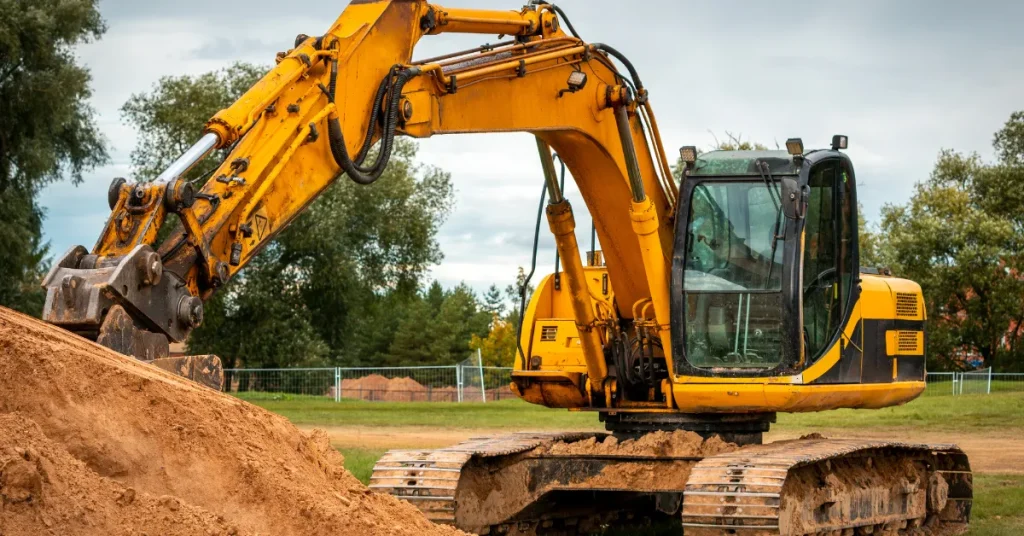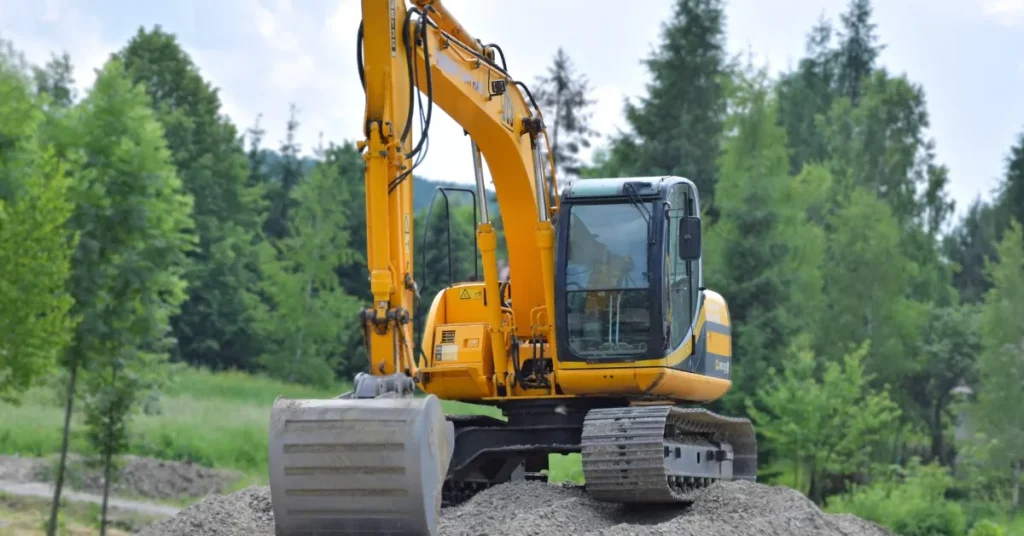The width of an excavator can range from under 1 meter to over 5 meters. It varies based on the model and size category of the excavator.
Excavators come in various sizes, designed for different kinds of work, from small-scale landscaping to massive construction projects.
Their width is a critical factor to consider, as it affects the machine’s ability to navigate and operate within a site. Compact or mini excavators are the narrowest, often necessary for tight spaces in urban construction or residential projects.
On the other side of the spectrum are the large excavators, boasting extensive reach and power, ideal for industrial applications.
Choosing the right width is essential for ensuring the excavator can efficiently and safely perform the task at hand, while also being able to maneuver around the work environment without causing disruption or damage.

The Scope Of Excavator Sizes
Excavators come in various sizes and shapes, each with its own set of abilities. These powerful machines are essential in construction and mining. They differ in size, from small, nimble units to enormous earthmovers. Below, we explore the range of excavator sizes.
Small Excavators: Compact Dimensions
Small excavators, often known as mini excavators, boast tight dimensions for easy access. These machines typically range:
- Width: 3.5 to 6 feet
- Weight: Around 2,000 to 10,000 pounds
- Applications: Landscaping, small construction
With their compact size, mini excavators excel in limited spaces.
Medium Excavators: Balancing Size And Power
Medium excavators strike a balance. They offer more power yet maintain reasonable size. Their specs include:
| Width | Weight |
| 6.5 to 9.5 feet | 10,000 to 50,000 pounds |
These excavators are ideal for mid-sized projects.
Large Excavators: The Giants Of Construction
Large excavators are true behemoths in the construction world. Their stats often are:
- Width: Over 10 feet
- Weight: Can exceed 50,000 pounds
Used in major projects, these giants handle heavy lifting with ease.
Decoding The Dimensions
When choosing an excavator, size matters. Not all excavators are built the same. Different projects need different sizes. Let’s dig into an excavator’s width, height, length, and how attachments can change its size.
Width: A Critical Measurement
The width of an excavator is crucial. It affects where it can go. Narrower machines fit in tight spaces. Oversized ones need more room but can move more dirt. Smaller machines often range from 3 to 5 feet wide. Larger models can be 10 feet wide or more.
Additional Measurements: Height And Length
Height and length are important too. Height is from the ground to the top of the cab. Length is from the front to back, including the boom. We measure excavators in these ways:
- Track to top of cab for height
- Counterweight to front blade for length
Smaller excavators may be around 8 feet tall and 15 feet long. Bigger ones can be over 10 feet high and 30 feet long.
The Impact Of Attachments On Excavator Width
Attachments make excavators do different jobs. They also change how wide they are. A bucket makes it wider. So does a hammer. Know the width with and without attachments. This tells you if it fits on your site.
| Attachment | Additional Width |
| Standard Bucket | 2-3 feet |
| Hammer | 2 feet |
| Claw | 3 feet |
Key Factors Influencing Excavator Width

Picking the right excavator involves many choices. One crucial decision is width. The width of an excavator impacts its use, transport, and where it can work. Here, we will look at the key factors that determine how wide an excavator might be.
Model And Manufacturer Variations
Different excavator models and manufacturers offer varying sizes. Widths change because each design serves a specific purpose. For example:
- Mini excavators are slimmer for small spaces.
- Larger models stretch wider for big projects.
Comparing brands reveals size differences, even for similar jobs. Hence, checking the model specifics is essential.
Purpose And Application: Customization Needs
The job a machine tackles greatly affects its width. Consider these points:
- Utility work often uses narrow excavators for tight areas.
- Demolition may need a wider base for stability.
Special attachments and modifications can alter width too, making excavators fit for special tasks.
Transportation Regulations And Limits
Importantly, moving excavators by truck has legal width limits. These regulations keep roads safe. They vary by location but often fall between 8.5 to 9 feet wide. Excavators beyond these limits need special permits or extra measures, like:
- Reduced speed,
- Specific travel times,
- Escort vehicles.
You must plan for this when picking an excavator size.
Practical Considerations In The Field
Practical considerations in the field shed light on the real-world applications of excavator dimensions. Construction professionals often evaluate these machines based on their width.
Understanding the width helps predict how they maneuver on-site, how much earth they can move, and what safety measures are essential. Here, we explore three vital factors affecting practical operations with excavators.
Navigating Through Construction Sites
Construction sites are diverse and often filled with obstacles. The width of an excavator determines whether it can pass through narrow spaces or structures. Tight gaps between buildings or natural features require slimmer models.
- Access routes must be wider than the excavator.
- Excavator size dictates transportation options.
- Project planning includes size considerations.
Impact On Earthmoving Capabilities
Width correlates with power. Larger excavators generally boast greater earthmoving capabilities. These machines move more material in a single pass.
| Excavator Size | Width Range | Earthmoving Capacity |
| Mini | 2-5 ft | Low |
| Medium | 5-10 ft | Moderate |
| Large | 10+ ft | High |
Safety Concerns Related To Size
The bigger the excavator, the more crucial safety protocols become. Operators must receive proper training. They ensure safety for themselves and workers on-site.
Visibility issues may increase with size. Backup cameras or spotters become necessary. Extra space is needed to prevent accidents.
- Training enhances operator awareness.
- Technology adds safety layers.
- Spacious sites reduce risk factors.
Comparing Excavator Models

When embarking on a construction project, knowing the width of your excavator plays a vital role. It impacts everything from transportation to its ability to navigate a worksite.
As such, comparing excavator models is an essential step in selecting the right equipment. Let’s delve into various models and match them to their projects.
Popular Excavator Models And Their Widths
Different excavator makes and models come with diverse specifications. Below is a snapshot of popular models and their widths:
| Model | Width |
| CAT 305E2 CR | 78 inches |
| Komatsu PC35MR-5 | 69 inches |
| Hitachi ZX50U-5N | 77 inches |
| John Deere 35G | 69 inches |
| Bobcat E35 | 69 inches |
Selecting The Right Excavator For A Job
To ensure optimal efficiency and safety, choosing the correct excavator size is crucial. Consider these factors:
- Job site space: Tighter spaces require slimmer models.
- Transport restrictions: Consider transportation means and road regulations.
- Task at hand: Match excavator capabilities with project demands.
Innovations In Excavator Design
Manufacturers continuously work to improve excavator design. Here are recent advancements:
- Hybrid systems for fuel efficiency
- Advanced hydraulics for precision
- Compact models for urban use
Compact excavators now offer greater power in smaller frames, ideal for narrow sites.
FAQs About How Wide Is An Excavator
How Wide Is A 10 Ton Excavator?
The width of a 10-ton excavator typically ranges from 7. 5 to 8. 5 feet (2. 3 to 2. 6 meters).
How Wide Is A 40 Ton Excavator?
A 40 ton excavator typically measures about 11 feet wide. Specific models may vary slightly in width.
How Wide Is A Bobcat Excavator?
Bobcat excavators come in various sizes; for example, the Bobcat E35 compact excavator is 69 inches wide. Check the specific model’s manual for exact dimensions.
What Is The Width Of A Mini Excavator?
The width of a mini excavator typically ranges from 28 inches to 79 inches, varying by model and make.
Conclusion
Summarizing the dimensions of excavators, width varies by model and type. It’s essential for job site navigation and transport considerations.
For tailored guidance, consult manuals or reach out to manufacturers. Remember, the right excavator width ensures efficiency and safety on every project.
Resources:
1. https://www.osha.gov/trenching-excavation/construction
